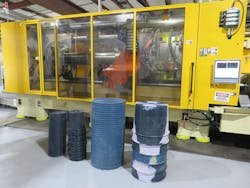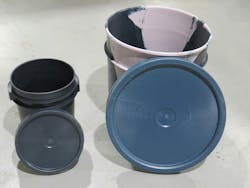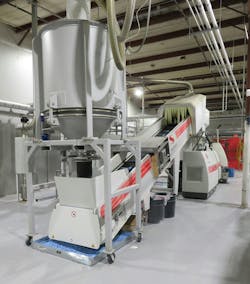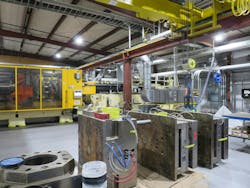From the Summer 2024 issue of Plastics Recycling.
By Ron Shinn
Recycled resin does not necessarily have to go into a new consumer part to be a circular economy superstar.
Clean Harbors, a major provider of environmental and industrial services in North America, has taken high-density polyethylene (HDPE) containers used mostly for lubricants and solvents that were previously shredded and sent to landfills, and worked out a way to recycle and injection mold them into containers it needs to incinerate toxic chemicals. Using these recycled pails means Clean Harbors no longer needs to purchase new pails and containers to fill with toxic chemicals that go into a 2,370-degree-Fahrenheit incinerator.
Before the in-house recycling project, Norwell, Mass.-based Clean Harbors was buying an estimated 2.5 million pounds of blow molded 30-gallon drums and 5-gallon injection molded pails per year made with virgin resin. The single-use containers were used solely for incineration of toxic materials.
To make this complex project successful, Clean Harbors had to work with Starlinger & Co. GmbH to turn the waste containers it collected from its customers into a uniform-sized material; Calframax Technologies Inc., which was later acquired by SyBridge Technologies, to build industrial pail molds; and Husky Technologies for a special three-nozzle hot runner system and a highly modified injection molding machine.
Clean Harbors, which had no injection molding experience, also had to train its staff to mold the pails and containers.
“This is one of the most satisfying projects I have been a part of,” says Andrew Kerley, Clean Harbors’ senior packaging engineer. “Taking a waste material, which in most cases was costing the company to discard and repurposing it to replace the raw material cost of new containers is Clean Harbors’ innovation in action. All the while we are reducing our environmental impact.”
Kerley declined to say how much Clean Harbors spent to buy the Starlinger recoSTAR recycling system, Husky injection molding machines and SyBridge Technologies molds, and to hire two additional employees, but he says the company expects to recoup its investment in less than three years.
Clean Harbors, a publicly traded company based in Norwell, Mass., has more than 400 service locations in North America, including more than 50 hazardous waste management facilities in the U.S., Canada, Mexico and Puerto Rico. Safety-Kleen is a well-known subsidiary.
The new recycling and molding operation is located at Clean Harbors’ El Dorado, Arkansas, facility, which specializes in high-temperature incineration of regulated waste materials such as industrial and laboratory chemicals, manufacturing by-products, medical waste, fertilizers and other solid and liquid materials that are hazardous to the environment and public health, Kerley says.
The project started in October 2018 and nine months later the collected material went through a test run on the Starlinger recoSTAR recycling system. Two months later, a proof of concept was completed at SyBridge in Ontario, but then COVID delayed the project. It was finally completed in August 2022.
The company collects and processes HDPE waste from many of its customers and the waste stream is far from homogeneous. It has a melt flow index (MFI) of less than 1. The high viscosity made blow molding impractical and injection molding very difficult.
An early challenge was to convince the machinery suppliers that the contaminated pails collected from customers could be used for this application. The material was finally tested and pelletized on the Starlinger system.
Once the recycled resin was converted to a uniform size, it was sent to the SyBridge facility in Windsor, Ontario, where industrial pail molds were designed and built.
The first test used an existing 5-gallon pail mold on a 500-ton Husky injection molding machine. Due to the resin’s high viscosity, it was very difficult to fill the mold more than halfway up the sidewall. Testing adjustments and mold modifications eventually overcame this problem, but there were limitations of temperature and pressure on the test machine setup.
However, SyBridge and Husky technicians were able to use data from the test to design a workable molding system.
Next, Clean Harbors commissioned SyBridge to design molds for 5-gallon and 22-gallon containers and lids that could be molded with fractional melt HDPE. At the same time, Husky built a specialized three-nozzle hot runner system for the 22-gallon container and a 1,200-ton Husky molding machine was configured for high torque, high injection pressure and equipped with a wear-resistant screw for the low-MFI HDPE.
The 22-gallon container’s shot size is 11 pounds, which necessitated the 1,200 tons of clamping force. The same machine also produces the 5-gallon pail and both lids. Husky designed the press with a 135mm screw and a 115mm screw, which makes the molding machine shorter than one with a single larger screw.
The three smaller molds can be filled using only the 115mm screw, which reduces energy consumption and improves shot control. A crane was installed over the machine to facilitate quick mold changes. Because the Clean Harbors facility has low ceilings, Husky built the press with a tie bar pulling option.
Today, the HDPE waste containers are collected at Clean Harbors sites across the country, shredded and then shipped to the Arkansas facility. There they are granulated and cleaned before being fed into a pelletizer.
The repelletized resin is put directly into the molding machine. Due to variations in recycled HDPE, operators need to make regular checks on the melt index and fine tune the molding machine when needed.
The 5-gallon pails and lids are being molded with 100 percent recycled resin. The 22-gallon container is currently using 70 percent recycled material and Clean Harbors is working to get that to 100 percent, Kerley says.
The staff to operate the recycling system and injection molding machine was trained primarily by equipment suppliers.
“We have developed a team of 16 employees to support this new process,” says Rico White, the company’s facility operations supervisor. “Prior experience with injection molding was limited to myself and one other. This process is different and challenging, but everyone has invested the energy needed to operate successfully.”
The recycling and molding operation runs 24 hours, six days per week with the seventh day for change over and maintenance. “The program has been successful and we are looking to expand the operation,” Kerley says.
For more information:
Clean Harbors (recycling services), 800-444-4244, www.cleanharbors.com
About the Author
Ron Shinn
Editor
Editor Ron Shinn is a co-founder of Plastics Machinery & Manufacturing and has been covering the plastics industry for more than 35 years. He leads the editorial team, directs coverage and sets the editorial calendar. He also writes features, including the Talking Points column and On the Factory Floor, and covers recycling and sustainability for PMM and Plastics Recycling.



